Pictorial Checklist of the Social Wasps
(Vespinae and Polistinae) of Michigan
Mark O'Brien
University of Michigan Museum of Zoology, Ann Arbor, MI
48109-1079
This list is based upon my research
and the collections of the University of Michigan Museum of
Zoology and Michigan State University Entomology Collection.
Any additional records are welcome. Just email
me.
SUBFAMILY POLISTINAE
Polistes fuscatus (Fabricius) - Common
Paper Wasp
Found all over the state, commonly builds it nests under overhanging eaves and similar sheltered areas. Predominantly a predator of insect larvae.
ADW Link |
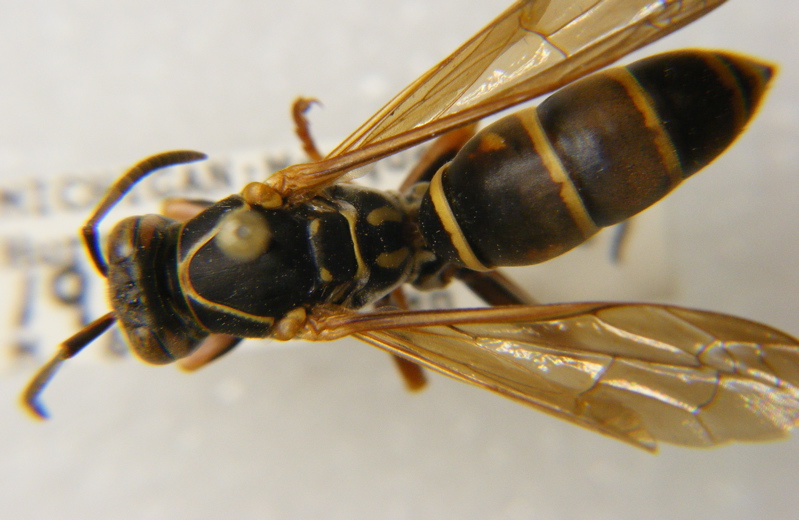 |
Polistes
dominulus (Christ) - European
paper wasp
This species has
rapidly become established across the lower part of Michigan. Nests may be found in almost any protected situation, even wheel wells of vehicles. There is some indication that this species has outcompeted our native Polistes in suburban habitats. |
 |
SUBFAMILY VESPINAE
[Note: only the queens are pictured below]
Dolichovespula
arctica (Rohwer)- Arctic Yellowjacket.
This species is an obligatory social parasite in nests of Dolichovespula arenaria and D. norvegicoides. The D. arctica queen eventually kills the host queen and uses the host workers to rear her brood.
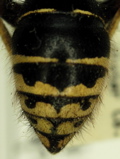
|
 |
Dolichovespula
arenaria (Fabr.)- Aerial Yellowjacket.
A very common yellowjacket, nests are usually constructed in sheltered spots above ground. They only feed on live prey, and are not quite the nuisance that other yellowjackets pose late in the summer.
ADW Link
|
 |
Dolichovespula maculata (Linn.)- Baldfaced Hornet
One of our most common vespids - the large aerial nests are easily recognized. This species is common all over MI, and is a predator of flies and other insects, including other social wasps and honeybees. They are often attracted to lights if the nest is near a porch light. They are only considered pests if a nest is somewhere where they are easily disturbed. 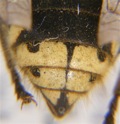
|
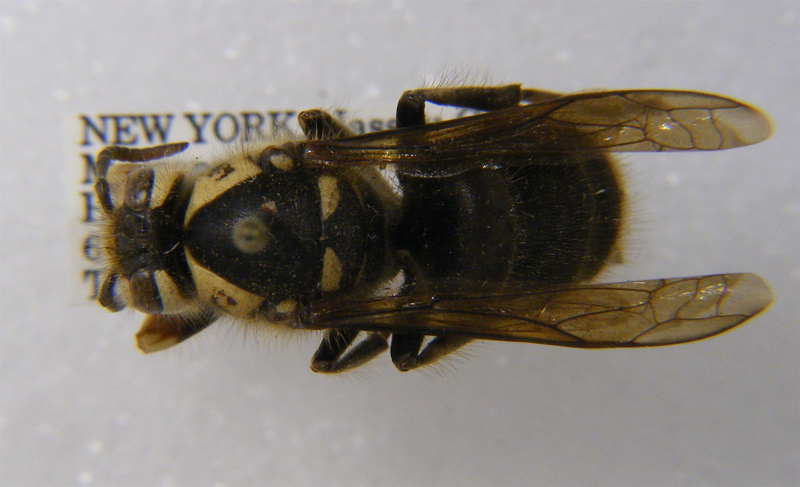 |
Dolichovespula
norvegicoides (Sladen)
Restricted to the UP and the tip of the lower peninsula, this species has small colonies, and the nests are in bushes not far from the ground.
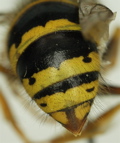
|
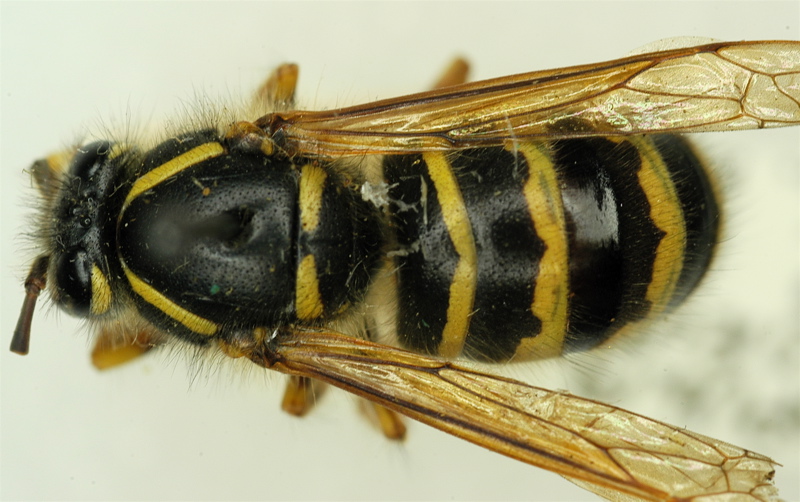 |
Vespula acadica (Sladen)- Forest Yellowjacket.
This is a boreal species that is rarely encountered. Colonies can be large, with over 400 workers, and if disturbed, they are reported to quite aggressive.
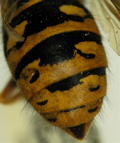
|
 |
Vespula austriaca (Panzer)- Boreal
Yellowjacket
Another boreal species, but is an obligatory social parasite of V. acadica and V. rufa.
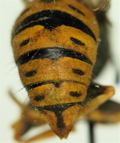
|
 |
Vespula consobrina (Sauss.)- Blackjacket.
This small black and white yellowjacket is a boreal species with subterranean nests. Colonies are small, with less than 100 workers per colony. It is found in forested areas.

|
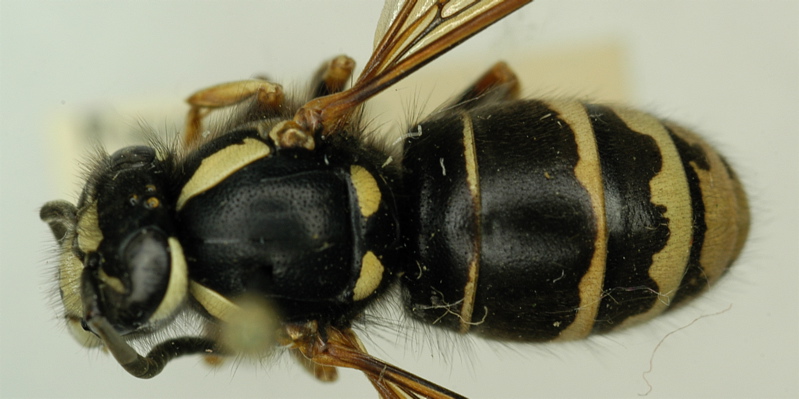 |
Vespula flavopilosa Jacobson- Hybrid
Yellowjacket.
This species was described in the 1970s, and is similar in behavior to V. maculifrons. The body has yellowish hairs. Nests are subterranean, and worker populations may be over 1000. Workers are scavengers, so they may pose a problem to people eating outside late in the summer. |
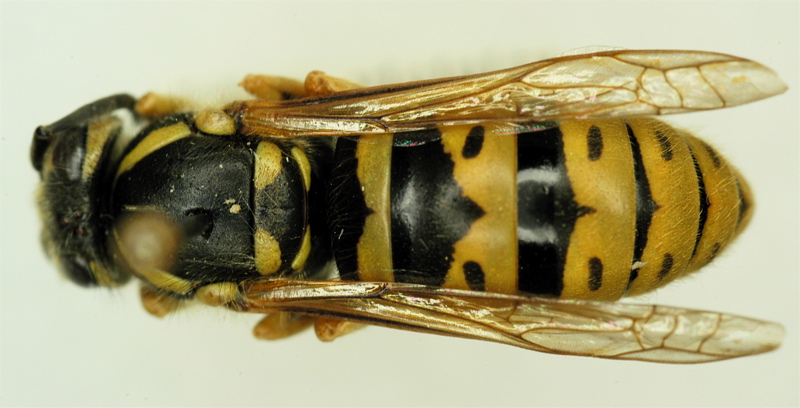 |
Vespula germanica (Fabr.)- German
Yellowjacket.
A European species, V. germanica has spread across the US. Colonies tend to be found in voids between walls of homes, and as a result, colonies produce new queens and workers into the fall months. Nests have been found to have over 10,000 cells! Adults are scavengers and are well-known for being attracted to sweets and meats, and are a common urban nuisance. |
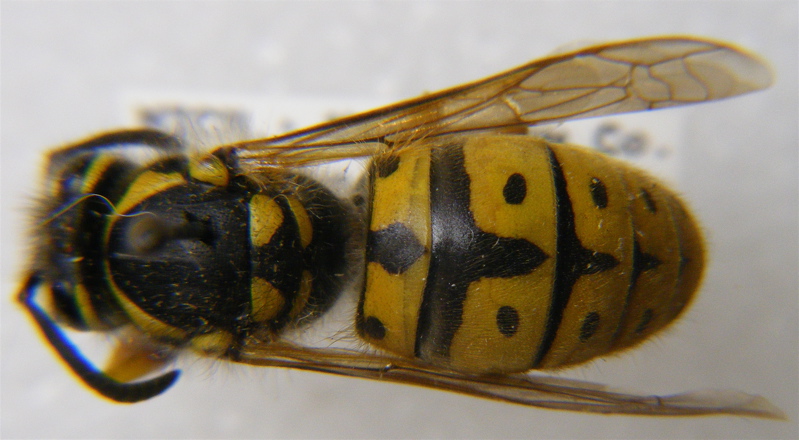 |
Vespula maculifrons (Buysson)- Eastern
Yellowjacket.
This is the subterranean-nesting species that one is likely to encounter while mowing a lawn or whacking weeds. It may be found in urban to rural locations, but disturbed habitats seem to be most favorable for it. Colonies may have over 3,000 workers, which prey on live insects and scavenge for food, as well. |
 |
Vespula squamosa (Drury)-
Southern Yellowjacket.
This large yellow jacket is our most colorful social wasp, and is found only in the lowest tier of Michigan counties, with its range extending into Mexico. This wasp is a facultative social parasite of V. maculifrons. Host workers rear the first brood of V. squamosa, with the parasite workers eventually taking over the nest. |
 |
Vespula vidua (Saussure)
This species is found primarily in the northeastern US. It apparently nests underground in disturbed areas, and colonies are small, with less than 400 workers. |
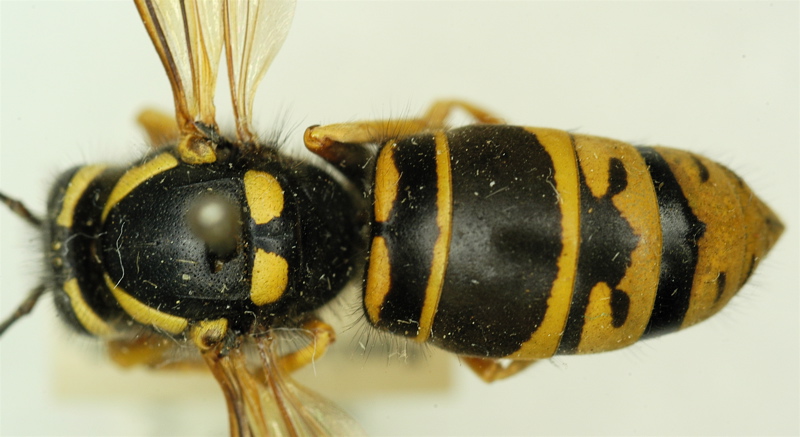 |
Vespula vulgaris (Linn.)- Old World
Yellowjacket.
This is a Holarctic species which is found across North America. Nests may be subterranean or in old stumps or rotting logs. Colonies may contain over 4,000 cells. Workers prey on a variety of insects such as caterpillars, beetle larvae, flies, and bugs. They are also attracted to protein and sugar sources and may be a fall nuisance.
|
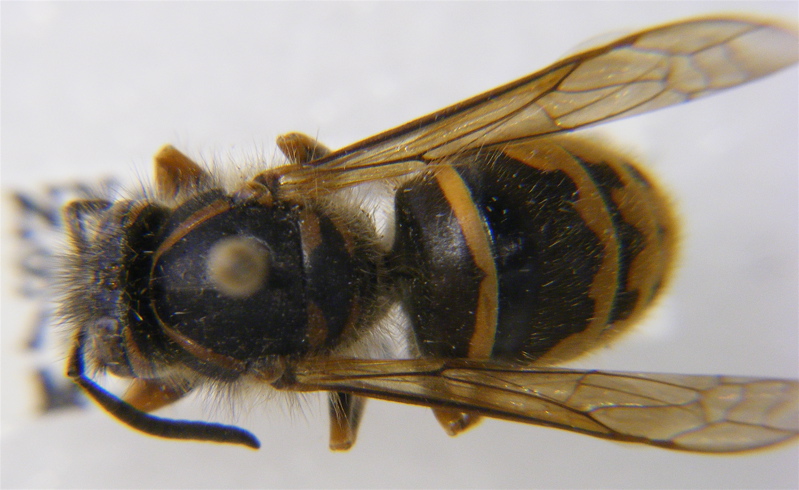 |
Useful References:
Akre, R.D., A. Greene, J.F. MacDonald, P.J. Landolt, and H.G. Davis. 1981. Yellowjackets of America North of Mexico. USDA Handbook No. 552, 102 pp.
Akre, R.D., H.C. Reed and P.J. Landolt. 1982. Nesting biology and behavior of the blackjacket, Vespula consobrina (Hymenoptera, Vespidae). J. Kansas Ent. Soc. 55:373-405.
Dreisbach, R.R. 1943. The genus Vespula (Hymenoptera, Vespidae) in Michigan, with keys and distribution. Pap. Michigan Acad. Arts Sci., and Letters 28:323-329.
Eberhard, M.J. W. 1969. The social biology of Polistine wasps. Misc. Publ. Univ. Mich. Mus. Zool. 140:101 pp. [PDF]
Gamboa, G.J., E.I. Greig and M.C. Thom. 2002. The comparative biology of two sympatric paper wasps, the native Polistes fuscatus and the invasive Polistes dominulus (Hymenoptera, Vespidae). Insects Sociaux. 49:45-49.
Greene, A., R.D. Akre and P.J. Landolt. 1978. Behavior of the yellowjacket social parasite, Dolichovespula arctica (Rohwer) (Hymenoptera: Vespidae). Melanderia. 29:1-28.
Jacobson, R.S., R.W. Matthews and J.F. MacDonald. 1978. A systematic study of the Vespula vulgaris group with a description of a new yellowjacket species in eastern North America (Hymenoptera: Vespidae). Ann. Entomol. Soc. Amer. 71:299-312.
Judd, T.M. and J.M. carpenter. 1996. Polistes dominulus (Hymenoptera: Vespidae) found in Michigan. Great Lakes Entomol. 29(1):45-46.
O'Brien, M.F. 1986. Social wasps of the Huron Mountains, Michigan (Hymenoptera: Vespidae). Great Lakes Entomol. 19:199-202.
Reed, H.C., R.D. Akre and B.W. Garnett. 1979. A North American host of the yellowjacket social paarasite Vespula austriaca (Panzer) (Hymenoptera: Vespidae). Entomol. News 90:110-113.
Last updated by Mark O'Brien, 03/10/2009




















